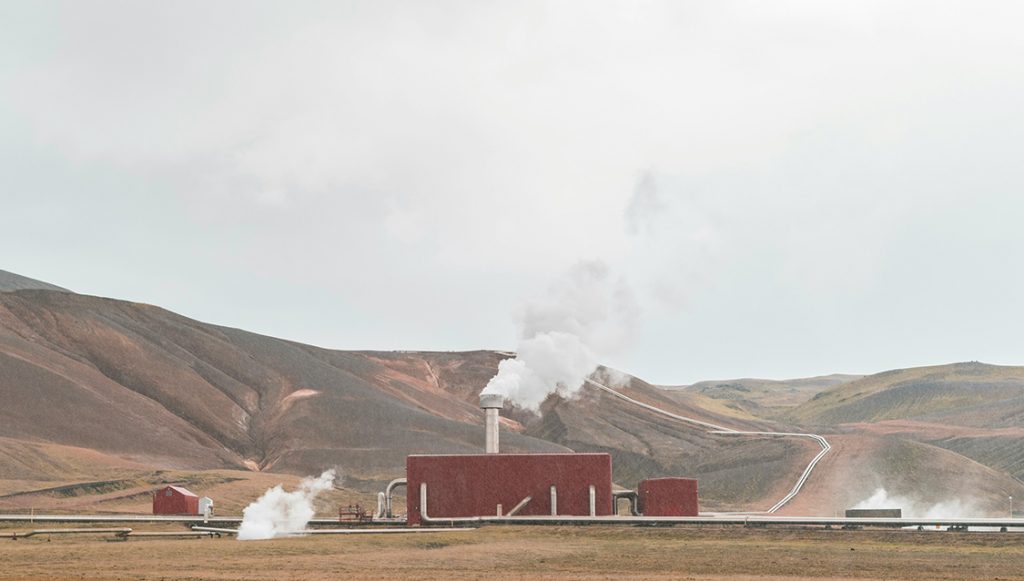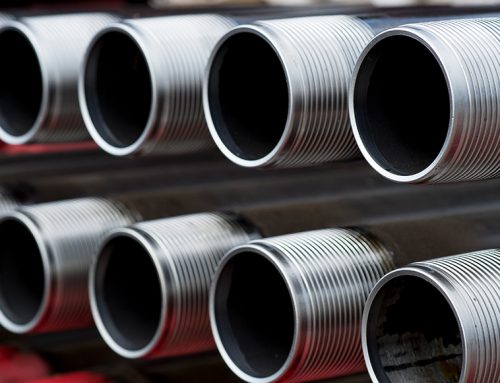What is geothermal technology?
Geothermal technology exploits the heat from the molten rock, or magma, beneath the Earth’s crust. It does this by using the steam produced when water is introduced to these extremely hot environments to turn turbines, which then generate electricity.
There are two main types of geothermal systems. In the case of hydrothermal systems, the water from which the steam is generated is already present beneath the crust. In contrast, enhanced geothermal systems require the careful injection of water into the hot rock formation to create steam, making it possible to generate geothermal energy even when no natural water reservoir is present.
Because magma beneath the Earth’s crust is naturally occurring and the harvesting of geothermal energy does not involve the removal of the molten rock source material, it is more or less an inexhaustible source of energy. Further, the greenhouse gas emissions generated by accessing this energy source are negligible compared to those produced from mining oil and gas. That being said, the collection of geothermal energy may create an extremely corrosive sour service (SS) environment. This can cause severe damage to the wellbore and wellhead, not to mention the surrounding environment, especially if incorrect materials are used.
In this blog, we’ll explore the different kinds of materials used to support geothermal technology, as well as the methodology for selecting the material or combination of materials appropriate for your given operation.
Materials analysis: Drilling for geothermal energy
Metallic materials
Soft and low alloyed metals, like low carbon steels, are best used in thick-walled systems and environments with a pH greater than 6 and low chloride ion concentration (below 2%). They work well when the corrosion rate is moderate (1-10 mpy) and are suitable for controlled flow conditions (5-7 fps). The use of protective coatings is beneficial for preventing corrosion on external surfaces.
These metals are not suitable for thin-walled systems due to high corrosion risks, including crack and pit formation. In environments with high chloride levels, the presence of hydrogen sulphide or low oxygen levels significantly increases the risk of local and uniform corrosion. They are also not recommended for high flow rate conditions or in the case of steel with over 1% nickel content due to the increased risk of corrosion and stress-related issues.
Stainless steels reduce the likelihood of uniform corrosion in geothermal drilling environments. Their resistance to pit and cracking corrosion depends on the chromium and molybdenum (Mo) content, especially in oxygen-free conditions. AISI 300 series stainless steels perform well in geothermal condensates at low temperatures and in oxygen-free geothermal fluids. AISI 400 series, particularly 13% chromium, is effective for turbine blades, pumps, and valve materials.
That being said, stainless steel can face several corrosion challenges, including pit corrosion, cracking corrosion, and breaking from stress corrosion. Increased chloride ion concentration and higher temperatures can exacerbate these issues. Further, austenitic stainless steels are prone to stress corrosion cracking in high-temperature, chloride-rich environments, while ferric stainless steels are generally more robust. Corrosion between particles is observed in both austenitic and ferric steels, especially during welding. Specific alloys, like AISI 430 (Ferrite), are recommended for components in high chloride geothermal fluid environments to prevent pit corrosion.
Titanium and titanium alloys excel in air-cooled or oil-cooled heat exchangers, showing corrosion rates generally below 0.3 mpy in geothermal fluids. Their corrosion rate remains stable even with temperature increases or higher chloride (Cl) ion concentrations. Titanium is also resistant to cavitation and impact damage, and flow rates up to 30 fps don’t affect its general corrosion resistance. Titanium alloys, such as Ti-code-7, Ti-code-12, and Ti-code-29, demonstrate enhanced resistance to local corrosion compared to pure titanium, particularly in high Cl environments.
Pit and cracking corrosions in titanium can occur at high temperatures and Cl ion concentrations above 10%. Titanium’s cathodic nature can cause galvanic corrosion when paired with other metals, and it is prone to hydrogen embrittlement. Titanium alloys are recommended when Cl ion concentration in geothermal fluid exceeds 5000 ppm and temperatures are above 100˚C. They are particularly effective in systems with oxygen intrusion, where stainless steel and nickel alloys may fail due to local corrosion. Ideal applications for titanium alloys include wellhead valves, pressure gauges, pipes, and blow-out preventers. For very harsh conditions, like high dissolved solids, low pH, and temperatures above 230˚C, titanium code 29 is preferred for pipe transport, with a service life exceeding 15 years and no renewal costs. It also helps prevent well plugging and damage, especially from iron-enriched silicate accumulations.
Nickel alloys, particularly Ni-Cr-Mo alloys, are highly recommended for use with high-temperature geothermal fluids due to their robust corrosion resistance. Specific alloys like Inconel-625 and Hastelloy C-256 demonstrate exceptional strength against corrosion. In some cases, similar alloys with iron elements are preferred for their mechanical properties and superior strength compared to stainless steel.
Certain nickel alloys may lack resistance to stress sulphur cracking or hydrogen embrittlement, especially in the presence of hydrogen sulphide. Ni-Cu alloys, in particular, are not suitable for use even in environments with low levels of hydrogen sulphide. This limitation necessitates careful selection of nickel alloys based on the specific environmental conditions and desired properties.
Copper based alloys being used in settings with high sulfur content is rare due to their susceptibility to corrosion. Copper alloys are known to develop cracks when exposed to ammonia or similar substances. When the levels of ammonia and ammonium are low, the incidence of cracks on copper alloy surfaces is reduced. In copper-zinc alloys, the risk of breakdown increases with higher zinc content.
Other metal-like materials, like aluminium alloys, have limited applications in harvesting geothermal energy because of their susceptibility to corrosion. However, cobalt alloys stand out for their application in areas that require high durability, particularly for abrasion strength and resistance to stress sulphur cracking. These alloys are also considered for use in parts at risk of zirconium and tantalum acidising.
Non-metallic materials
These materials, such as concrete and polymer compositions and elastomers, are increasingly used in geothermal fields and drilling operations. They often demonstrate superior corrosion resistance when compared to metals and alloys. Additionally, they offer financial benefits, including lower initial investment costs and extended operating and maintenance periods, making them cost-effective over the long term.
Despite these advantages, non-metallic materials are not suitable for use in heat transfer equipment. Their properties and functionality in such applications may not meet the required standards, limiting their use to other areas within geothermal operations.
Materials selection philosophy
When deciding on whether materials are fit-for-purpose (FFP) for your geothermal energy operation, it’s important first to collect information on the relevant corrosion challenges. This will involve a review of well and pipeline data and the identification of standard corrosion mitigation practices.
After obtaining information about well/flow conditions, you’ll be able to develop a shortlist of materials to be tested. To undertake FFP testing, you’ll need to simulate the corrosion parameters, such as pH, acidic gases, temperature and so on, under the worst possible conditions. FFP testing should be carried out on this basis for both flow and shut in conditions.
The FFP tests for SS must include general corrosion, sulfide stress cracking (if H₂S exists) and stress corrosion cracking at specific flow/well conditions. If oxygen contamination is considered a risk, testing for SS localised corrosion, such as crevice corrosion, must also be carried out. Furthermore, if sands are considered to be in the flow, erosion-corrosion tests might be required too.
Once you have completed this testing, you should have the information you need to evaluate whether one or more of your shortlisted materials is appropriate. If no candidate is deemed suitable, use your findings to develop a new shortlist and repeat the FFP testing process.
Geothermal drilling and OCTG
The harsh conditions of geothermal fields demand materials that can withstand extreme temperatures, corrosive fluids, and varying pressure levels. These volatile environments are analogous to those in which the oil and gas industry operates on a daily basis, making OCTG and linepipe well-suited to assist in the harvesting of geothermal energy. This is particularly true of OCTG in SS environments, where these products’ resistance to corrosion and ability to withstand high pressure and maintain integrity at elevated temperatures has become invaluable.
As we have explored, materials like stainless steel, titanium alloys, nickel alloys, and even non-metallic alternatives all have a role in supporting geothermal drilling projects, with the precise choice of material governed by the characteristics of the operation and the environment. The careful selection and integration of these materials not only enhances the efficiency and longevity of geothermal operations but also paves the way for more sustainable and reliable energy production, aligning with the industry’s move towards cleaner, renewable energy sources.
Explore the range of ready-made OCTG suitable for SS environments that’s available for purchase through Pipesales’ global marketplace.






